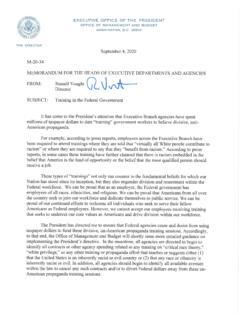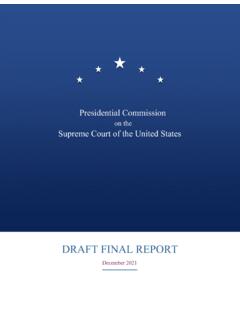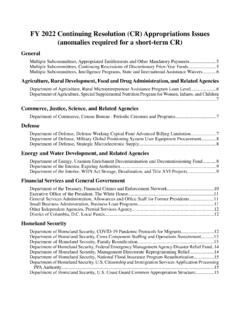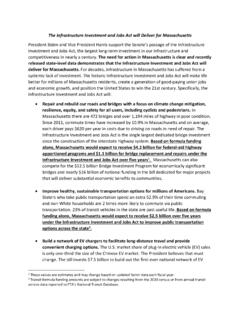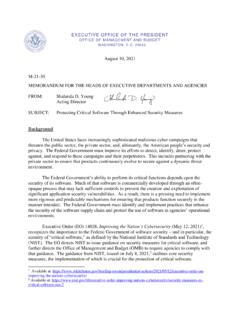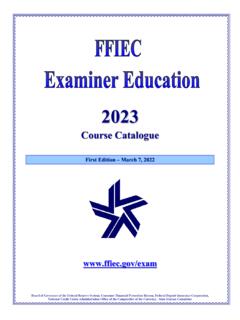Transcription of BUDGET CONCEPTS AND BUDGET PROCESS - The White …
1 53 BUDGET CONCEPTS AND BUDGET PROCESS556. BUDGET CONCEPTSThe BUDGET system of the United States Government provides the means for the President and the Congress to decide how much money to spend, what to spend it on, and how to raise the money they have decided to spend. Through the BUDGET system, they determine the allocation of resources among the agencies of the Federal Government and between the Federal Government and the private sector. The BUDGET system focuses primar-ily on dollars, but it also allocates other resources, such as Federal employment.
2 The decisions made in the bud-get PROCESS affect the Nation as a whole, State and local governments, and individual Americans. Many BUDGET decisions have worldwide significance. The Congress and the President enact BUDGET decisions into law. The BUDGET system ensures that these laws are carried chapter provides an overview of the BUDGET system and explains some of the more important BUDGET CONCEPTS . It includes summary dollar amounts to illustrate major CONCEPTS , and enumerates specific policies or presentation choices in the 2022 BUDGET associated with some of these CONCEPTS .
3 Other chapters of the BUDGET documents dis-cuss these CONCEPTS and more detailed amounts in greater following section discusses the BUDGET PROCESS , cov-ering formulation of the President s BUDGET , action by the Congress, BUDGET enforcement, and execution of enacted BUDGET laws. The next section provides information on BUDGET coverage, including a discussion of on- BUDGET and off- BUDGET amounts, functional classification, presenta-tion of BUDGET data, types of funds, and full-cost budgeting. Subsequent sections discuss the CONCEPTS of receipts and collections, BUDGET authority, and outlays.
4 These sections are followed by discussions of Federal credit; surpluses, deficits, and means of financing; Federal employment; and the basis for the BUDGET figures. A glossary of BUDGET terms appears at the end of the laws, enacted to carry out requirements of the Constitution, govern the BUDGET system. The chapter re-fers to the principal ones by title throughout the text and gives complete citations in the section just preceding the BUDGET PROCESSThe BUDGET PROCESS has three main phases, each of which is related to the others:1. Formulation of the President s BUDGET ;2.
5 Action by the Congress; and3. Execution of enacted BUDGET of the President s BudgetThe BUDGET of the United States Government consists of several volumes that set forth the President s fiscal policy goals and priorities for the allocation of resources by the Government. The primary focus of the BUDGET is on the BUDGET year the next fiscal year for which the Congress needs to make appropriations, in this case 2022. (Fiscal year 2022 will begin on October 1, 2021, and end on September 30, 2022.) The BUDGET also covers the nine years following the BUDGET year in order to reflect the effect of BUDGET decisions over the longer term.
6 It includes the funding levels provided for the current year, in this case 2021, which allows the reader to compare the President s BUDGET proposals with the most recently enacted levels. The BUDGET also includes data on the most recently com-pleted fiscal year, in this case 2020, so that the reader can compare BUDGET estimates to actual accounting a normal year (excluding transitions between Administrations), the President begins the PROCESS of for-mulating the BUDGET by establishing general BUDGET and fiscal policy guidelines, usually by late spring of each year.
7 Based on these guidelines, the Office of Management and BUDGET (OMB) works with the Federal agencies to estab-lish specific policy directions and planning levels to guide the preparation of their BUDGET the formulation of the BUDGET , the President, the Director of OMB, and other officials in the Executive Office of the President continually exchange information, proposals, and evaluations bearing on policy decisions with the Secretaries of the Departments and the heads of the other Government agencies. Decisions reflected in previously enacted budgets, including the one for the fiscal year in progress, reactions to the last proposed bud-get (which the Congress is considering at the same time the PROCESS of preparing the forthcoming BUDGET begins)
8 , and evaluations of program performance all influence decisions concerning the forthcoming BUDGET , as do pro-jections of the economic outlook, prepared jointly by the Council of Economic Advisers, OMB, and the Department of the normally submit their BUDGET requests to OMB, where analysts review them and identify issues that OMB officials need to discuss with the agencies. OMB and the agencies resolve many issues themselves. Others require the involvement of White House policy of-ficials and the President. This decision-making PROCESS 56 ANALYTICAL PERSPECTIVESis usually completed by late December.
9 At that time, the final stage of developing detailed BUDGET data and the preparation of the BUDGET documents decision-makers must consider the effects of eco-nomic and technical assumptions on the BUDGET estimates. Interest rates, economic growth, the rate of inflation, the unemployment rate, and the number of people eligible for various benefit programs, among other factors, affect Government spending and receipts. Small changes in these assumptions can alter BUDGET estimates by many billions of dollars. (Chapter 2, Economic Assumptions and Overview, provides more information on this subject.)
10 Thus, the BUDGET formulation PROCESS involves the simultaneous consideration of the resource needs of in-dividual programs, the allocation of resources among the agencies and functions of the Federal Government, and the total outlays and receipts that are appropriate in light of current and prospective economic law governing the President s BUDGET requires the transmittal of the following fiscal year s BUDGET to the Congress on or after the first Monday in January but not later than the first Monday in February of each year.


